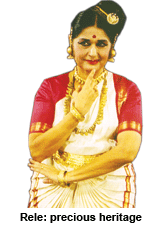With formal study and acquiring of degrees in dance now commonplace, trained classical dancers can become professional performers, teachers and choreographers
From royal courts, kothas and temples, Indian classical dance has acquired social respectability moving into the halls of higher education institutions, and is being considered by a growing number of youth as a dignified and worthwhile career. With performance opportunities multiplying, a career in dance could prove very satisfying for classical dance aficio-nados, because it has also transformed into a financially rewarding option.
India boasts dance traditions stret-ching back five millennia. Among the most well-known classical dance forms are Bharatnatyam of Tamil Nadu; Odissi (Odisha); Kathakali and Mohini Attam (Kerala); Kuchipudi (Andhra Pradesh); Kathak (Lucknow and Jaipur) and Manipuri (Manipur).
Individuals trained in classical dance can become professional performers, teachers and even choreographers. In the life of a performing artiste, there’s very little time for activities not directly linked to dance. Most of them also run their own schools or institutes where they pass on their skills and expertise to the next generation. Many dance divas form troupes from among their students and stage dance dramas and ballet performances. With formal study and acquiring degrees in dance now commonplace, teaching dance has also become an attractive career choice. Teachers well-versed in the theory and practice of classical dance are much sought after by schools, universities and cultural institutions as a rapidly growing number of children are signing up for classical dance lessons.
Training in dance imparted by professional institutes tends to be comprehensive, covering theory and practice of various dance forms, and prepares students for performance or teaching careers. Admission eligibility is usually completion of secondary school (class X).
Among the leading classical dance teaching institutions are: Natya Institute of Kathak and Choreography, Bangalore (BA and postgrad diploma); Nalanda Nritya Kala Mahavidyalaya, Mumbai (BA, MA and Ph D); J.G. College of Performing Arts, Ahmedabad (BA, MA); Rukmini Devi College of Fine Arts at Kalakshetra Foundation, Chennai (two-year post-diploma programme); Univ-ersity of Madras (MA Bharatnatyam); Kalamandalam, deemed university for art and culture, Thrissur (BA and MA); College of Indian Music, Dance and Dramatics, MS University, Baroda.
 With the entertainment industry and performing arts enjoying boom condi-tions, and a growing number of middle class parents anxious to encourage co-curricular and cultural education of children, teachers both part-time and full-time are always needed in schools and universities. For professionally trained choreographers, there are opportunities aplenty in films, stage, television and video music programmes. Professionally qualified teachers start at Rs.25,000-30,000 per month in high-end international schools and univer-sities, and those who run their own schools can easily bank Rs.50,000. The services of performers and choreo-graphers too are much in demand and once they acquire name and fame, financial rewards are huge. With performing artistes’ careers being short, most of them also teach part-time which qualifies them to become full-time teachers after retirement from the stage.
With the entertainment industry and performing arts enjoying boom condi-tions, and a growing number of middle class parents anxious to encourage co-curricular and cultural education of children, teachers both part-time and full-time are always needed in schools and universities. For professionally trained choreographers, there are opportunities aplenty in films, stage, television and video music programmes. Professionally qualified teachers start at Rs.25,000-30,000 per month in high-end international schools and univer-sities, and those who run their own schools can easily bank Rs.50,000. The services of performers and choreo-graphers too are much in demand and once they acquire name and fame, financial rewards are huge. With performing artistes’ careers being short, most of them also teach part-time which qualifies them to become full-time teachers after retirement from the stage.
“These days, formal education in dance is necessary as there’s a massive demand for professionally qualified teachers,’’ notes Dr. Kanak Rele, a renowned Mohini Attam exponent, academic and founder of the Nalanda Dance Research Centre (1966) and founder-principal of the Nalanda Nritya Kala Mahavidyalaya (estb. 1972).
Discouraged by her family from pursuing a dance career, Rele studied law at Bombay University and was awarded a Masters degree in inter-national law by Manchester University in 1960. However after returning from the UK, instead of practicing law she rediscovered her passion for classical dance, and emerged as a leading performer of Mohini Attam.
“I started kathakali training as a very young girl under the late Guru Panchali Karunakaran Pannikar and thereafter in Mohini Attam. On my return from the UK, I immersed myself in the study and execution of classical dance forms,’’ she recalls. In 1966, she founded Nalanda Dance Research Centre, Mumbai, officially acknowledged as a research institute by the Union ministry of science and technology, and recognised internationally as the premier institution for research in India’s classical dance forms.
Subsequently in 1972, Rele promoted Nalanda Nritya Kala Mahavidyalaya. This prompted Mumbai University to introduce its bachelor and Master of fine arts and Ph D (dance) degree progra-mmes, transforming the institution into an exclusive college of Indian classical dance.
Pleased that a growing number of youth are being initiated into classical dance and the performing arts, Rele says: “I really hope we never lose the guru-shishya parampara (teacher-pupil tradition) which is unique to our culture and art forms,’’ adding that with the revival of interest in Indian heritage, the future of classical dance looks very bright. “It’s a precious heritage rooted in traditions going back 5,000 years. We should do all we can to preserve, re-interpret and develop it,’’ she says.
Indra Gidwani (Mumbai)